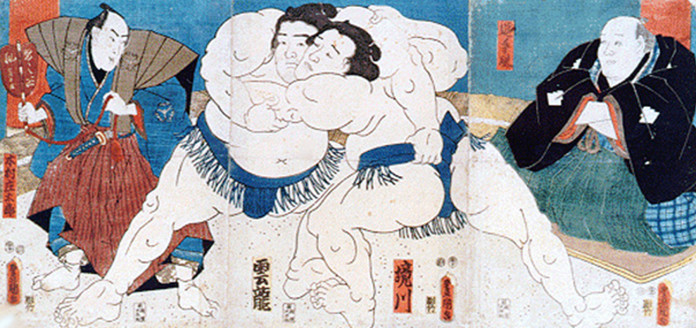
As well as a trial of strength in combat and as a Shinto ritual, Sumo was an important ritual at the imperial court. Representatives of each province were ordered to attend the contest at the court and fight. The contest was known as Sumai no Sechie 相撲の節会 or “Sumai party”.Over the rest of Japanese recorded history, Sumo’s popularity has changed according to the whims of its rulers and the need for its use as a training tool in periods of civil strife. The form of wrestling combat probably changed gradually into one where the main aim in victory was to throw one’s opponent. The concept of pushing one’s opponent out of a defined area came some time later.
Also, it is believed that a ring, defined as something other than simply the area given to the wrestlers by spectators, came into being in the 16th century as a result of a tournament organized by the then principal warlord in Japan, Oda Nobunaga 織田信長. At this point wrestlers would wear loose loincloths, rather than the much stiffer Mawashi of today. During the Edo period, wrestlers would wear a fringed Kesho-mawashi during the bout, whereas today these are worn only during pre-tournament rituals. Most of the rest of the current forms within the sport developed in the early Edo period.
 Professional Sumo (Ozumo大相撲) can trace its roots back to the Edo period in Japan as a form of sporting entertainment. The original wrestlers were probably Samurai 侍, often Ronin浪人, who needed to find an alternative form of income.Current professional Sumo tournaments began in the Tomioka Hachiman Shrine 富岡八幡 宮 in 1684, and then were held in the Ekō-in 回 向院 in the Edo period. They have been held in the RyōgokuKokugikan 両国国技館 since 1909, though the KuramaeKokugikan 蔵前国技館 had been used for the tournaments in the post-war years until 1984. Nations adjacent to Japan, sharing many cultural traditions, also feature styles of traditional wrestling that bear resemblance to Sumo.
Professional Sumo (Ozumo大相撲) can trace its roots back to the Edo period in Japan as a form of sporting entertainment. The original wrestlers were probably Samurai 侍, often Ronin浪人, who needed to find an alternative form of income.Current professional Sumo tournaments began in the Tomioka Hachiman Shrine 富岡八幡 宮 in 1684, and then were held in the Ekō-in 回 向院 in the Edo period. They have been held in the RyōgokuKokugikan 両国国技館 since 1909, though the KuramaeKokugikan 蔵前国技館 had been used for the tournaments in the post-war years until 1984. Nations adjacent to Japan, sharing many cultural traditions, also feature styles of traditional wrestling that bear resemblance to Sumo.
(…to be continued.)










